The first stage of the Proton rocket (original) (raw)
Related pages:
Searching for details:
The author of this page will appreciate comments, corrections and imagery related to the subject. Please contact Anatoly Zak.
Proton's first stage: this is all one thing!
The design of the first stage had forever defined Proton's unique architecture. No other launch vehicle before or after it had the same design and when this architecture started emerging from behind the Iron Curtain, it became a great source of mystery and confusion.
Previous chapter: Proton rocket home page
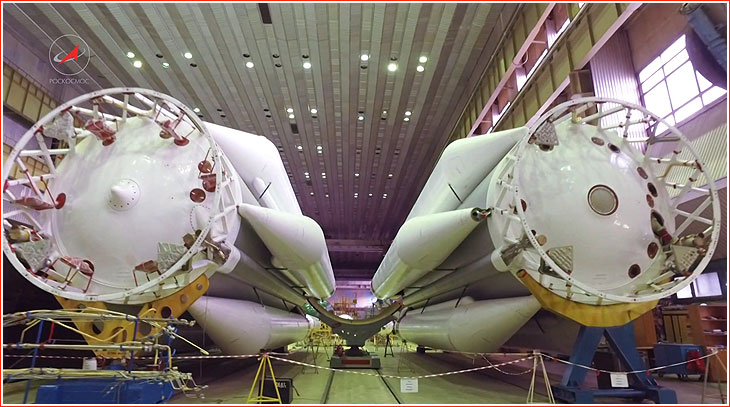
Designated 8S810KM, the first stage of the Proton-M rocket is comprised of a central (core) oxidizer tank, surrounded by six strap-on fuel tanks. Each of stage's six engines are attached to the one of the strap-on tanks, however the entire cluster of tanks remains connected during the flight. Sectioning of the first stage was dictated by the transportation restrictions, not by flight dynamics. The core tank of the stage has a diameter of 4.1 meters, which is an absolute maximum still allowing its delivery by rail.
The first stage is connected to the second stage with a lattice structure manufactured from the aluminum alloy V95. It is designed to let exhaust gas from the engines on the second stage to escape as they fire shortly before the separation of two stages around two minutes after liftoff.
With the introduction of the Proton-M version of the rocket in 2001, the first stage was slightly lightened thanks to improved manufacturing techniques and the reduction in the mass of onboard avionics. In addition, RD-253 engines used on the first stage had been upgraded and, from 1993, they were designated RD-275. Yet another upgrade of the engine became known as RD-276.
Another upgrade on the first stage involved its propellant feed system. It was simplified and redesigned in order to reduce by as much as 50 percent the amount of propellant remaining inside the stage by the time it finishes firing close to two minutes into the flight. A special propellant purge system was added to dump all residuals from the spent first and second stages before they fall back to earth. Although the main purpose of this change was to reduce controversial spills of toxic propellants at the impact sites downrange from Baikonur, the rocket's performance was also improved as a result.
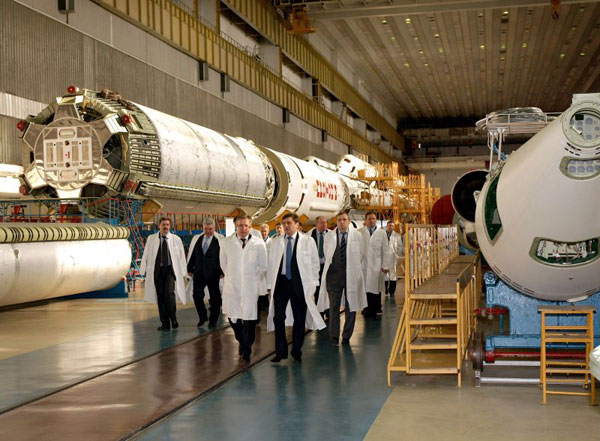
The core tank of Proton's first stage (left) before the installation of strapon tanks (right). Credit: GKNPTs Khrunichev
Technical specifications of the first stage of the original Proton-K rocket:
| Dry mass | 34,000 kilograms |
|---|---|
| Fueled mass | 685,280 kilograms |
| Liftoff mass | 683,680 kilograms |
| Oxidizer mass | 300,870 kilograms |
| Fuel mass | 113,710 kilograms |
| The end mass | 280,110 kilograms |
| Liftoff to end mass ratio | 2.44 |
| Propulsion system thrust to liftoff mass ratio | 1.33 |
| Burn time | 126.6 seconds |
Technical specifications of the first stage of the Proton-K and Proton-M rocket:
| - | Proton-K | Proton-M |
|---|---|---|
| Maximum diameter (a cluster of core and strap-on tanks) | 7.4 meters | 7.4 meters |
| Diameter of core (oxidizer) tank | 4.1 meters | 4.1 meters |
| Diameter of strap-on fuel tanks (each of six) | 1.6 meters | 1.6 meters |
| A total length of the first stage | 20.2 meters | 21.18 meters |
| Propulsion system | Six RD-253, later RD-275 engines | Six RD-275/276 engines |
| A total thrust of the first stage at sea level (all six engines combined) | 9.5 meganewtons | 10.0 meganewtons |
| A total dry mass of the first stage | approximately 31,000 kilograms | approximately 30,600 kilograms |
| A total mass of propellant in the first stage | approximately 419,410 kilograms | ? |
| Separation time | T+126.7 seconds* | T+119.7 - 123.3 seconds* |
| Separation speed | 1,649 meters per second* | 1,680.4 - 1,796 meters per second |
| Separation altitude | 43.5 kilometers* | 42.4 - 42.48 kilometers* |
| Latitude of impact location | - | 47 degrees 18 minutes 23 seconds North |
| Longitude of impact location | - | 66 degrees 33 minutes 27 seconds East |
| Distance of impact location from the launch site | - | 306 kilometers |
*Varies depending on a particular mission
Next chapter: RD-253 / RD-275 engine
Page author: Anatoly Zak
Last update:April 3, 2023
All rights reserved
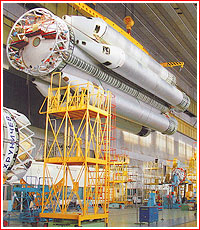
The first stage of the Proton rocket during the assembly. Credit: GKNPTs Khrunichev
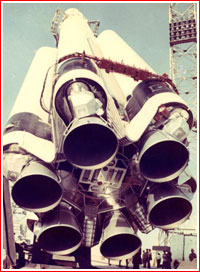
A launch pad view of Proton's first stage. Credit: GKNPTs Khrunichev
A business end of the Proton rocket with six RD-275 engines arranged in a circle on the first stage. Click to enlarge. Copyright © 2000 Anatoly Zak
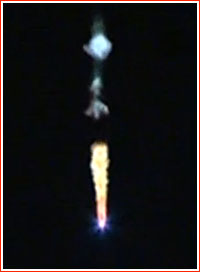
Separation of the Proton's first stage during the launch of the Eutelsat-9B satellite as seen by ground cameras. Credit: ILS

First stage of the Proton rocket separates during the launch of Elektro-L No. 4 satellite in 2023.

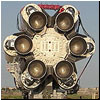


)